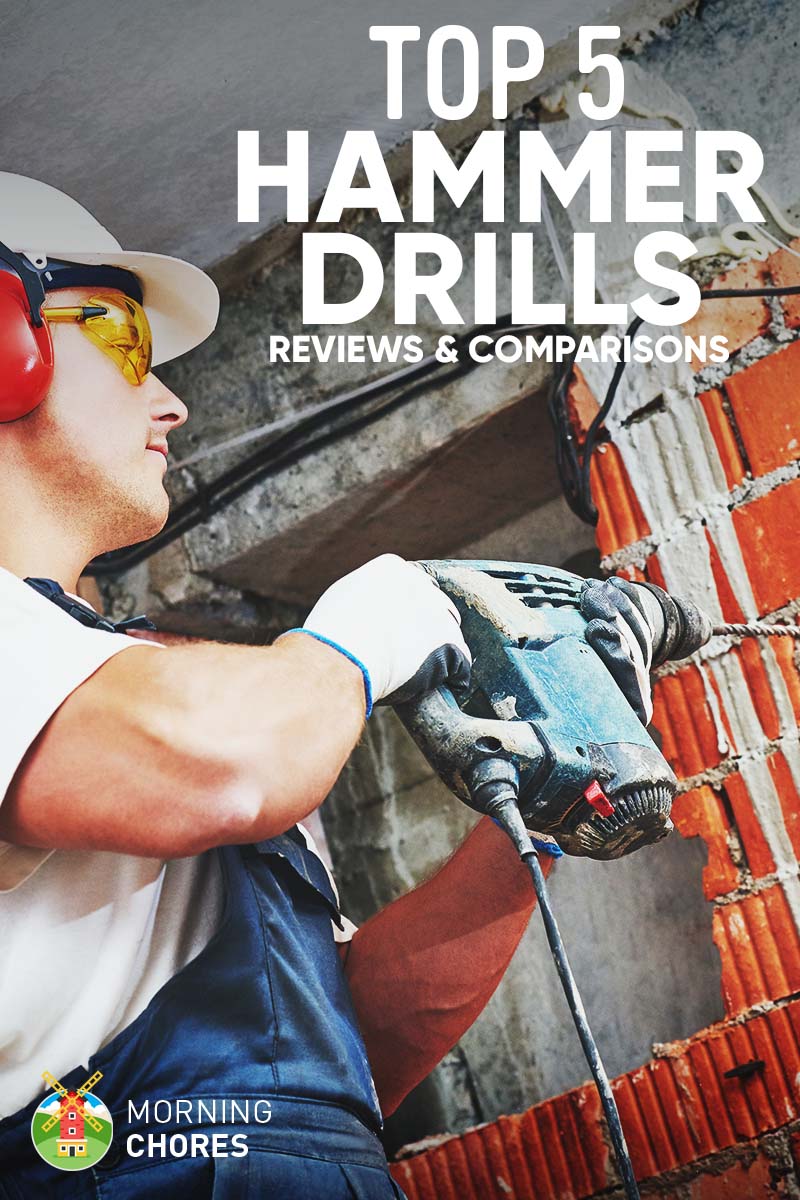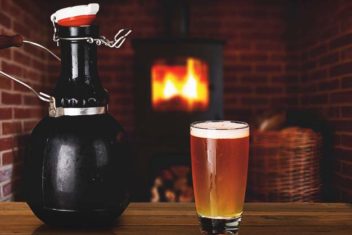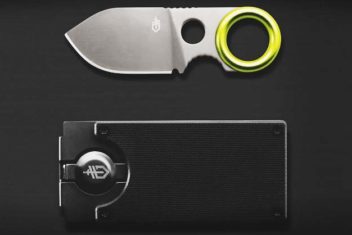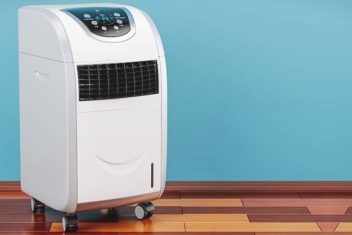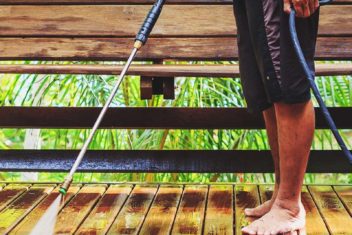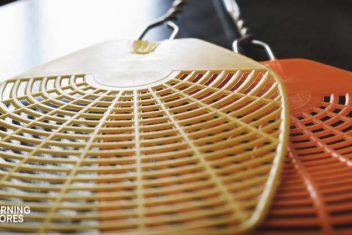A hammer drill is one of the best power tools to have around your home. Basically, it is a power drill with a hammer function. The hammer smacks the drill so it can help drill even further. Unlike a power drill – which is more ideal for tackling light to medium DIY projects like attaching shelves, mounting wall brackets, attaching fixtures to stone walls, or remodeling your basement — a hammer drill is better used for more heavy-duty tasks like drilling and breaking concrete or bricks.
Hammer drills have a similar power to an impact drill driver where it rotates and bores into the material’s surface, but it uses more pressure. Remember: The hammer drill setting is NOT to be used for driving in screws.
A hammer drill could also be called a mini jackhammer as it produces short, rapid bursts that can drive holes into surfaces where other drills would fear to tread like hardwood, steel, brick, and mortar.
It is super fast and has a clutch that allows the drill to spin in and out of the surface very quickly. Remember: hammer drills can take some getting used to as they vibrate a lot and they are very loud and they can have a lot of kick-back.
The 5 Best Hammer Drills
- Bosch 1191VSRK Single-Speed Hammer Drill
- Makita Hammer Drill Kit
- DEWALT Hammer Drill
- Ryobi P1813 Hammer Drill Power Tool Kit
- MILWAUKEE Electric Tools 2804-22 Hammer Drill Kit (Our Top Pick)
Our Top Pick for the Best Hammer Drill
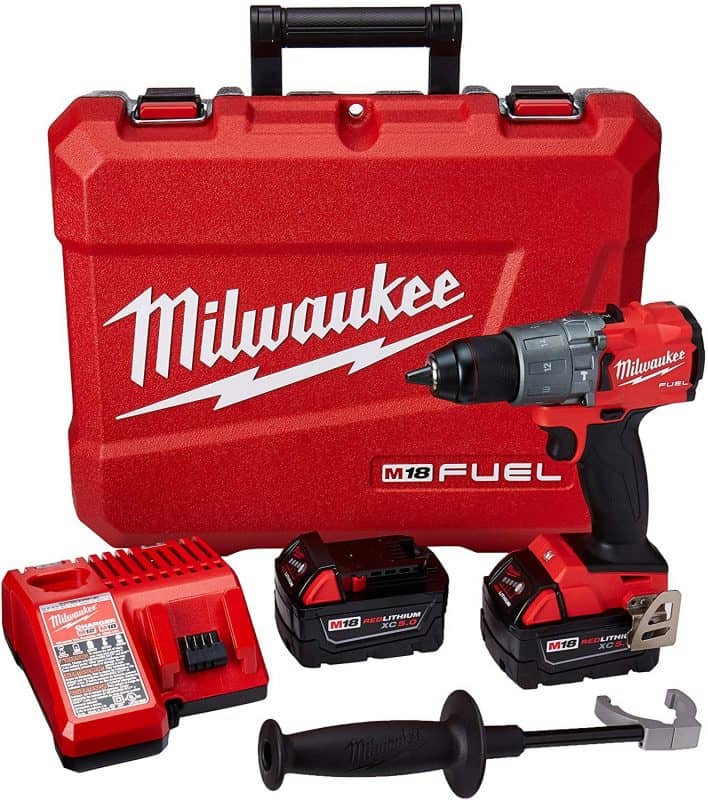
Our top pick for the best hammer drill is the MILWAUKEE Electric Tools 2804-22 Hammer Drill Kit.
If you are looking for a compact drill that can provide you with easy handling and maneuverability, MILWAUKEE is a great choice for all of those light to medium DIY tasks in and around your home. It is a sturdy well-made drill, which can deliver the power and overall drilling performance you need for most drilling applications.
Check the price on AmazonHammer Drill Specifications
There are so many powerful tools that are available in the marketplace and they are heavily competing for the attention of all DIYers and handymen and women.
Some hammer drills come as a “tool-only” or “bare tool”, which means you have to purchase the battery and charger separately. Other drills come with additional parts like an extra handle for the drill, and a handy carrying case.
Remember: There are 7 key features to look out for when you searching for the right hammer drill for your home: Power Source, Motor Power, Torque and Speed, Chuck Size, Reversible Function, Transmission, and Operator Comfort Features.
1. Power Source: Electric (corded) or Battery-operated (cordless)
Hammer drills can be powered by electricity or by a battery, usually an 18-20-volt lithium-ion battery. Battery-powered drills are portable, so you can use them anywhere in and around your home. You can take them with you if you go on holiday, and you do not have to worry about the power cord.
Electric hammer drills are more cumbersome and you have to make sure that you are close to a power outlet or use a heavy-duty extension cord. However, the best thing about electric hammer drills is that they are more powerful and deliver a constant flow of power, which is ideal for working with extra tough material like stone or concrete.
2. Motor Power
If you will be doing light to medium DIY tasks around your home, then an electric hammer drill that has a motor that ranges in power from 5-8 amps will be sufficient. Drills with this power range are ideal for drilling holes up to ½-inch in a block, mortar, brick, and another light masonry. These drills will also bore into concrete, but it will take you longer.
Remember: A more powerful motor will improve the overall speed and action of the drill and will save you from burning out the motor.
3. Torque Power and Speed
The power and the speed of the drill are measured by the torque, which is the amount of force behind the drill that rotates the drill bit into position. The higher the torque the more power or force the drill can produce. Also, some hammer drills indicate how many Blows Per Minute (BPM) they can produce on tough building material like brick, stone, or concrete.
The drilling speed relates to the number of revolutions or rotations (RPM) that the drill can perform per minute. The higher the RPM’s the faster the drill will be. A cordless drill will operate at an average of 1500 RPM. Whereas a corded one has a higher speed of up to 2000-3000 RPM.
The drilling speed will depend on the type of material or surface you will be working with. Drilling through lighter materials like wood or plastic will use a lower speed, but with tougher materials like metal or concrete, you will need a hammer drill with a higher speed.
4. Chuck Size
The size of the hammer drill is determined by the size of the chuck that is located at the end of the drill. The chuck is where the drill bit is to be attached. Chuck sizes can be ½, ¼, or ⅝-inch. Some models give you a keyless chuck, which means you do not need any tools to attach or remove it.
5. Reversible Function
The forward/reverse switch allows you to control the direction of the drill. With a flick of a switch, you can shift the drill into a forward or reverse motion, which is ideal for removing a drill when it is stuck in a hole.
6. Transmission
Single-speed hammer drills are generally lighter and have only one speed or gear to choose from. They are ideal for drilling into wood and aluminum. Two-speed hammer drills give you a choice of two types of transmission or gear speeds. A two-speed hammer drill can be heavier than a single speed, but they have more drilling power.
In first gear, they deliver a slower RPM but have a higher torque. In the second gear, the RPM will be faster, but the torque or turning force is reduced. Hammer drills that have two speeds are ideal for drilling small holes in wood and metal.
7. Operator Comfort Features
Working with a power tool for long periods or especially when you are crouched in a tight space can put a lot of stress on your arms and hands, and other parts of your body. So when you are looking for the perfect tool fit, look at the ergonomic or comfortable design features of the drill.
A good tip for checking the comfort specifications of a hammer drill (besides reading this buyer’s guide, of course), is to visit your local hardware store and try out the drills that have been reviewed here. Or a similar model from the manufacturer. Also, you could learn some drilling tips on how to use your hammer drill.
Choosing the Right Hammer Drills
Ask yourself these 3 questions when you are looking to buy a hammer drill.
1. Is the Drill Light and Well Balanced?
Although the hammer drill is similar to other power tools like the impact driver-drill, it can be heavier and it can cause a lot of vibrations. So it should feel comfortable in your hand and be easy to use. A lightweight drill or one that is well-balanced is ideal for tasks that might take you a while to complete, or for tasks that can cause strain on your arms, like reaching up to the ceiling to attach a light fitting.
2. Does it Have a Soft Grip Handle or an Extra Handle?
A drill with a soft grip handle allows you to maintain a firm grip on the tool, which makes it easier to maneuver in tight spots or for drilling through tough material.
Some manufacturers provide an extra handle on the hammer drill that is positioned on the side or located near the front of the tool. This extra handle is really useful for drilling holes in a straight-on horizontal position into concrete as it gives you more purchase on the drill. Some hammer drills have a handle that rotates 360°, but they can be a little difficult for people with large hands.
3. Does it Have Extra Safety Features?
Look for extra safety features like a lock-on button where you do not have to hold the trigger down all the time during the drilling process. Some drills come with their own carrying case that keeps the drill from getting misplaced and helps to keep the drill in good condition.
5 Best Hammer Drills – Reviews
1. Bosch 1191VSRK Single-Speed Hammer Drill
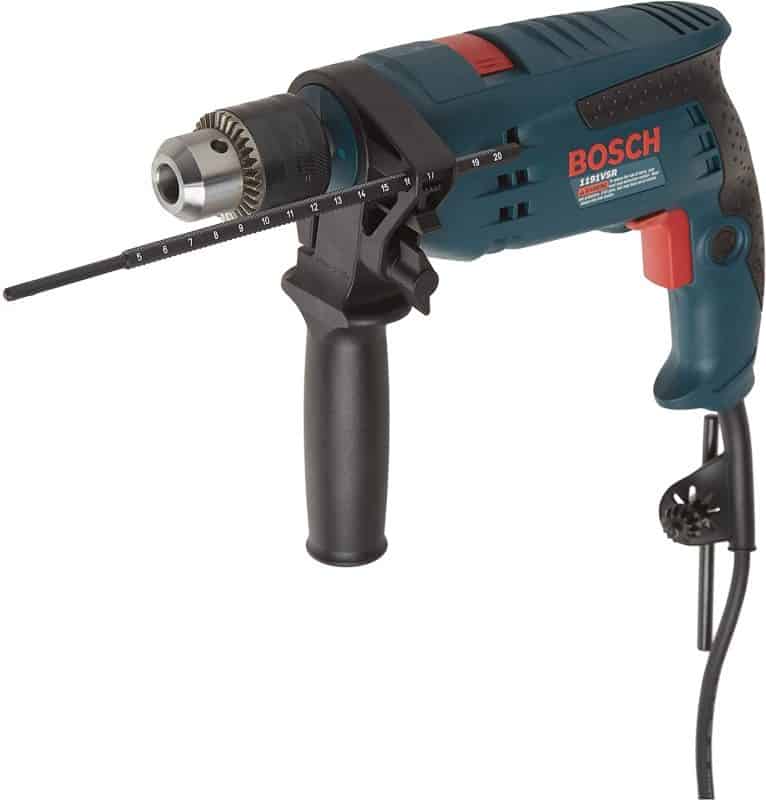
The Bosch 1191VSRK Single-Speed Hammer Drill has a lot of attractive features that make it the ideal choice for light-duty DIY applications, or if you have never used a hammer drill. It is durable and lightweight, but can still deliver the drilling action you need with a 120-volt 7 amp motor that can drill up to 3000 RPMs. With 48 000 max BPMs, it will have no trouble drilling into hardwood and steel.
A sturdy well-made drill, has a variable speed selector, a reversing switch for removing bits, or when the drill gets stuck. There is a two-mode operation selector so that you can easily switch between using the drill for “rotation only”. For added power, you choose to operate the drill with the “hammering with rotation” mode.
It is comfortable to use with an ergonomic handle that provides you with multiple gripping positions. A 360° side handle with a built-in, quick-release depth gauge also gives you that much-needed accuracy and control while you work. The drill also comes with an auxiliary handle, depth rod, chuck key, and carrying case.
Pros
- Ideal for light-duty DIY
- Durable
- Easy to use
- Good size and weight
- Powerful
- Variable-speed
- Reversible
Cons
- Not ideal for heavy-duty tasks
- Not ideal for concrete
2. Makita Hammer Drill Kit
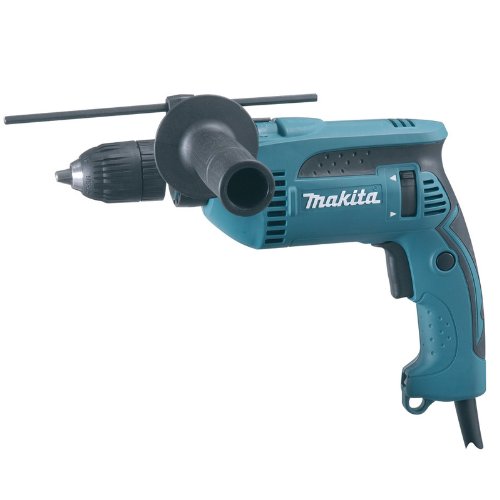
Once again Makita delivers the goods with its Hammer Drill Kit. A durable and high-quality drill that has loads of power with a 6 amp motor giving you an output of 2800 RPM and up to 44 800 BPM. It is lightweight at 4.4lbs, yet it is still able to be used for the toughest DIY renovations around your home.
The two-mode operation means you can use it for rotation purposes, or when you need extra drilling power you can switch it to the ‘hammering with rotation” mode. The all-ball bearing construction and the extended life motor brushes provide the tool with longer life and an overall smooth running performance.
For that much-needed operator comfort, the drill has a soft-grip handle and an extra handle that is attached to the side of the drill, which gives you both comfort and control when you are working in tight spots and for drilling through extra tough surfaces.
An extra safety feature is the recessed lock-on button, which gives you continuous drilling action when you are using the drill for longer periods. A depth gauge helps you monitor the depth of your drilling. The keyless chuck allows you to easily change drill bits. The drill also comes with a handy carrying case.
Pros
- Excellent hammer drill
- Lightweight
- Ideal for hard surfaces like concrete
- Very powerful
Cons
- Chuck is not very good quality
- Carrying case made out of cheap plastic
3. DEWALT Hammer Drill

If you are looking for a hammer drill that can easily tackle tough surfaces like steel or masonry then look no further than the DEWALT Hammer Drill. With a 7.8 amp motor, a high torque of 2700 RPM, this drill can power through most DIY or tough maintenance applications in and around your home.
The DEWALT drill gives variable speed modes so you can easily change the speed of your drilling depending on whatever surface you will be working on, from low speed for more precision drilling and high speed for boring deep holes.
The dual-mode allows you to quickly switch between using the tool as an ordinary drill driver or as a hammer drill for drilling into concrete. The drill is also reversible, which is a handy feature for when the drill gets stuck or you have to remove a drill bit.
Although it packs a lot of power, it is still quite light at 4.3lbs. It has extra operator features like a 360° side handle with a depth rod that offers greater control and overall precise drilling performance.
The 7.8 amp motor has overload protection, and the two-finger rubber trigger gives you that much-needed comfort for those tasks that might take you a while to complete. As it is powered by electricity, the drill also comes with an 8-feet power cord. Extra features include a 360° side handle, depth rod, and chuck key with holder.
Pros
- Ideal for medium-duty tasks
- Easy to use
- High quality
- Strong and powerful
- Good size and weight
- Fast
- Accurate
- Three-year limited warranty
Cons
- Not ideal for light wood surfaces
- No key-less chuck
- Expensive
4. Ryobi P1813 Hammer Drill Power Tool Kit
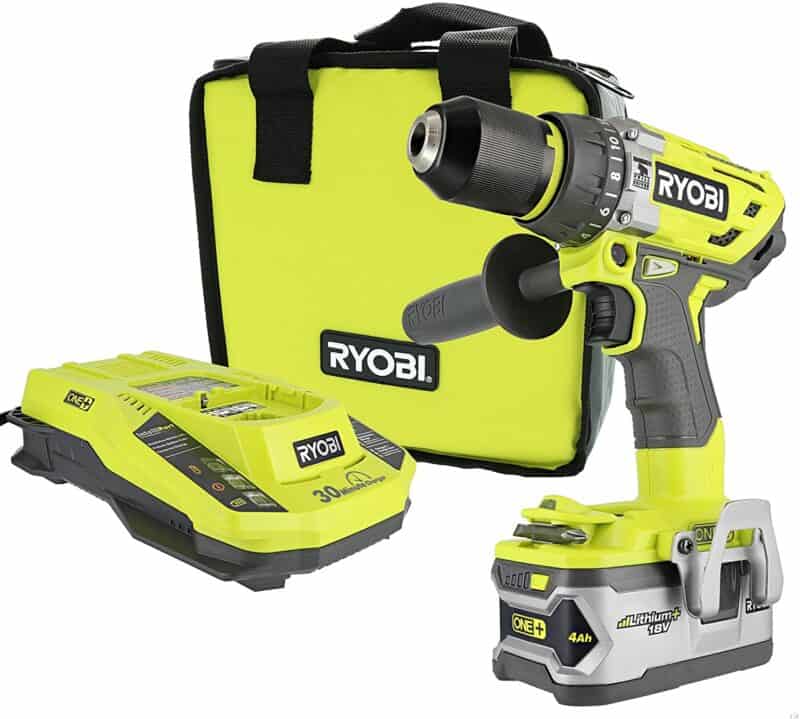
Sturdy and powerful, the Ryobi P1813 Hammer Drill Power Tool Kit is the perfect choice for those small to medium-duty DIY tasks around your home.
You can use the P1813 as an ordinary drill driver for lighter work applications. Or if you need some extra drilling power, it can be used for drilling holes in concrete. It produces up to 750-inch-pounds in torque. Variable RPM speeds range from 0-410 and 0-1 800 and BPM speeds from 0-5-400-0-23 000 BPM. The 24 position clutch gives you more control when you need to work with different materials.
The Ryobi ONE+ is also loaded with handy operator features that will make your DIY chores so much faster to complete. The drill has a ½-inch single-sleeve keyless all-metal chuck that allows you to easily change drill bits.
You can store all your bits and screws into the magnetic holder at the base of the tool. The GRIPZONE ™ handle provides you with a firm grip on the tool and the bonus handle can be screwed into either side of the unit. This hammer drill is ready to use as it comes with an 18-volt lithium-ion battery and charger and even a handy tool bag.
Pros
- Ideal for small to medium DIY chores
- Good size and weight
- Durable
- Powerful
- Strong
- Extra handle
Cons
- Not ideal for drilling through very thick concrete
5. MILWAUKEE Electric Tools 2804-22 Hammer Drill Kit

This MILWAUKEE Electric Tools 2804-22 Hammer Drill Kit is one of the most compact hammer drills on the market. However, don’t be fooled by its size. It is a well-made drill with loads of power for small to medium maintenance and DIY tasks.
It can handle most drilling applications and surfaces but can struggle with thick concrete. An all-around greater performer, this variable-speed hammer drill delivers up to 60% more power, drills up to 2X faster on high speed, and can produce up to 1200 in-lbs of torque, so you will be powering through your DIY tasks in a flash.
The drill’s red and black all-metal casing is solid and the ½-inch single sleeve ratcheting chuck is also made from metal. Smart REDLINK Intelligence ™ protects the tool from overheating when you are using it for more demanding tasks.
This compact cordless drill fits snugly in your hand, which is ideal for those moments when you have to work in tight spaces. The built-in LED light illuminates low-light working areas. It even comes with a side handle, battery pack, charger, belt clip, belt holder, and a durable carrying case.
Pros
- High quality
- Ideal for small to medium-duty tasks
- Good value for money
- Compact
- Comfortable fit
- Well built
- Very powerful
Cons
- Not ideal for heavy-duty tasks
- Chuck wobbles a bit when it rotates in thick material
- Bit heavy
Our Top Pick for the Best Hammer Drill

Our top pick for the best hammer drill is the MILWAUKEE Electric Tools 2804-22 Hammer Drill Kit.
If you are looking for a compact drill that can provide you with easy handling and maneuverability, MILWAUKEE is a great choice for all of those light to medium DIY tasks in and around your home. It is a sturdy well-made drill, which can deliver the power and overall drilling performance you need for most drilling applications.
Check the price on Amazon